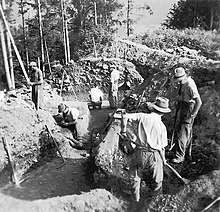Borscht site
The archaeological site of Borscht in the Principality of Liechtenstein is one of the oldest Neolithic sites in the central Alpine region, which is geologically isolated from Mediterranean influences. The finds of rock crystal , stone, antlers and bones were unearthed many years ago on the Schellenberg Borscht rock plateau on the Eschnerberg.
location
The Eschnerberg rises as a crossbar from the Rhine plain. Its topography offered people of all cultures settlement space in a protected location, especially since the swampy valleys covered by dense riparian forests were not habitable. This is borne out by the borscht, Lutzengüetle (2 km away), Malanser, Sägaweiher and Schneller sites, whose names have established themselves in the archaeological world as fixed terms for settlement development in the Alpine Rhine Valley .
Excavation and publication
The first excavations on the Borscht took place in the 1930s. Although the findings caused a sensation among experts, they remained without scientific evaluation. Only special (Borscht fauna) or summarizing reports were published. As in the entire western Alpine foothills, the share of wild animal bones increased during the Neolithic from around 10 to 40%, and later dropped to around 2%. In 1999, the monograph written by Magdalena Mczyska appeared in three volumes on settlement structures, shards of vessels and metal finds from borscht. With the fourth volume by Mathias Seifert, published in 2004, the Borscht is fully accessible as an archaeological source to experts and interested laypeople.
Time position
The timing of the settlement phases can be narrowed down to exactly 100 years thanks to scientific methods. The farmers of the Neolithic, Bronze and Iron Ages built on the Borscht from the 5th to the 1st millennium BC. Their villages. During the settlement period examined, there were contacts in all directions within the Alpine region. The analysis of the firestones and rocks reveals raw material relationships in the Alpine and northern Italian regions as early as the Neolithic. The shape of the oldest tools and devices, on the other hand, shows connections to the Rössen culture in Baden-Württemberg. Despite the diverse connections, the shapes of the devices show a certain independent development in the Rhine Valley. B. started earlier than in Vorarlberg .
literature
- Mathias Seifert: Schellenberg-Borscht. A prehistoric settlement in the Principality of Liechtenstein. Vol. IV. The finds from deer antlers, bones field rock, flint and rock crystal. Triesen, 2004.
Web links
- Anna Merz: Borscht (Buerst). In: Historical Lexicon of the Principality of Liechtenstein .
Coordinates: 47 ° 14 '8.5 " N , 9 ° 33' 33.3" E ; CH1903: 760560 / two hundred thirty-three thousand eight hundred twelve
